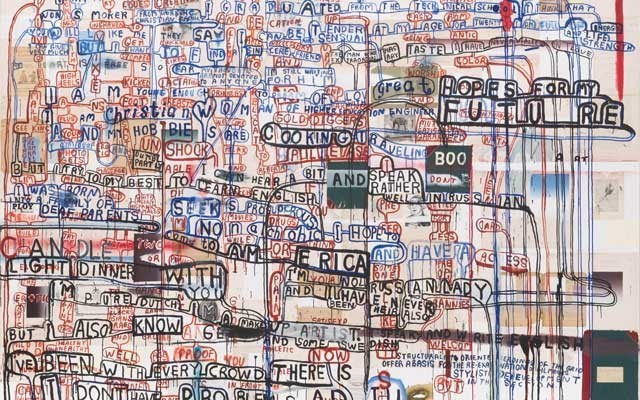The work of Vancouver artist Graham Gillmore could attract curious writers just as easily as it attracts art lovers.
Whether he creates a painting, panel or sculpture, words figure heavily and have so for years.
Gillmore says that when he attended Emily Carr University of Art + Design in the early '80s, German neo-expressionism convinced him to paint figuratively.
"That was the flavour of the month. It became kind of tedious after a while to explain what things were supposed to look like," he says.
"I still wanted to follow a narrative and a story behind the work, even though I wanted to make abstract paintings. Using language enabled me to tell stories and be quite specific about the direction of the story, while maintaining an allegiance to non-representational art."
His large painting Ploy (2003) is part of the permanent collection at the Audain Art Museum, and captures this style. He has received many emails from people who have become fans of his work after viewing it.
"They say it mystified them and opened their eyes up to the possibilities of what image-making can be all about," he says.
Asked where the source or inspiration came from for Ploy, Gillmore says he pulled the language he used from a stack of mail-order-bride catalogues.
"It was an endless amount of fun to go through those," he says.
"There are a bunch of voices in Ploy that are operating simultaneously. Some of them contradict each other; some are oblivious to each other. It's about subjects looking for love and companionship.
"It was one of the first pieces when I started weaving the messages. There are vertical and horizontal lines, you're following one and then you get derailed."
Gillmore gives the next hour-long "Meet Our Artists" talk at the Audain on Saturday, Sept. 2, at 2 p.m. Entry is free to museum members, or included with the purchase of admission.
Talking about art is not something he does often.
"I don't get the chance to do this very much. Whenever I am asked to speak, I usually do it. I feel obligated to share some of my stories, but painting is a practice that is sometimes hard to talk about," Gillmore says.
"I think a lot of painters would say the same, though some are so erudite that it blows my mind."
While perhaps "isolated" is too strong a word to use, most painters certainly work in solitude, he adds.
"It's one of the main reasons I became a painter. I like being alone in a big white room!" Gillmore laughs.
"That's also why I've kept my practice fairly simple. I make a lot of work, and I am able to make a living at it. It's not that I exhibit everything I make, but I find myself needing to go through the motions, through the act of creating something to figure it out — the experiential thing that happens on the canvas, paper or panel."
Asked if his process of creation is organic, Gillmore says that he does plan his work out in advance, "or I would never get anywhere."
He adds: "The exciting parts of what I do are the accidents and the unexpected turns, the backfirings and visions."
Gillmore will be exploring his career and approach to art during his talk, and will show around 50 images of past creations from different points in his career.
"The idea will be to walk viewers through how forms, ideas and concepts evolve," he says.
For more information, visit audainartmuseum.com or grahamgillmore.com.




